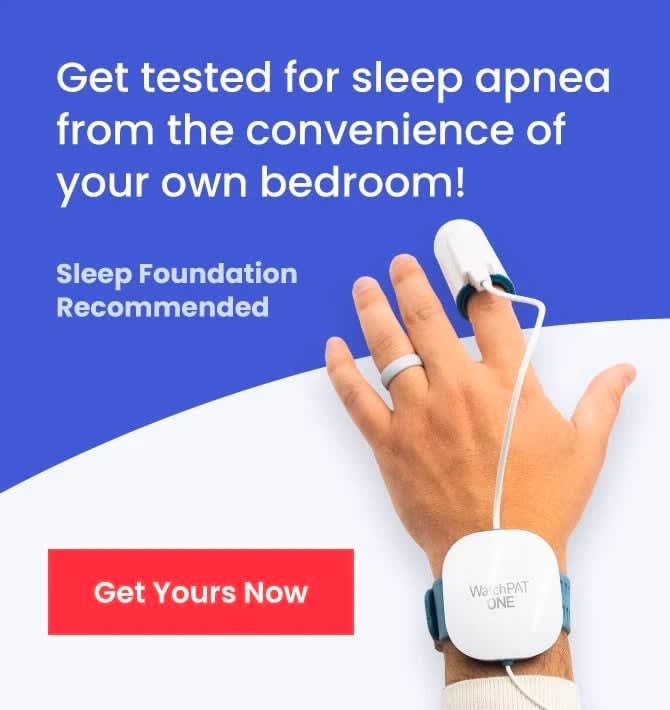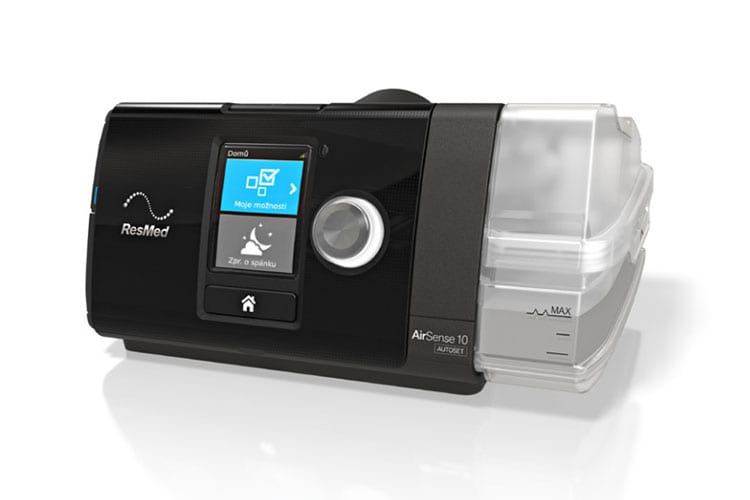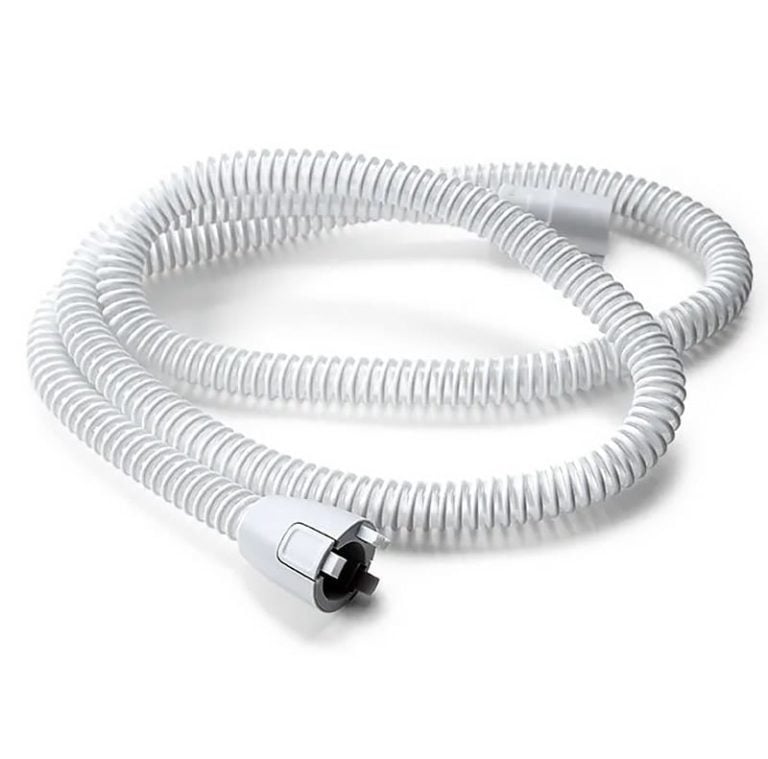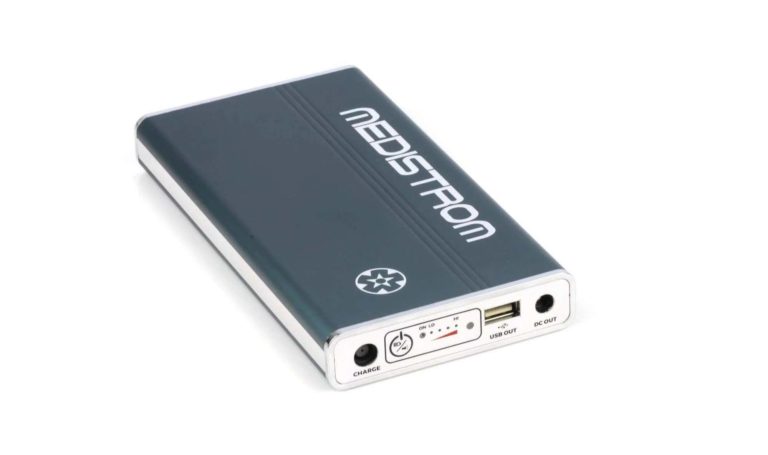When you buy through our links, we may earn a commission. Products or services may be offered by an affiliated entity. Learn more.
CPAP Humidifiers
Continuous positive airway pressure (CPAP) therapy is commonly prescribed for those who suffer from sleep apnea. A CPAP humidifier is a device that releases moisture from a small tank of distilled water into the air that you breathe from your CPAP machine. This helps increase your comfort level during CPAP therapy.
CPAP therapy can reduce moisture in the nasal airways, which may lead to issues like dry mouth, dry throat, cracked lips, nosebleeds, chest pain, and nasal infections. Humidifiers helps prevent these issues during CPAP therapy by adding moisturized air.
There are two different types of humidifiers: built-in and external. Built-in humidifiers are part of the CPAP machine. External humidifiers are separate components that attach to your CPAP machine.
Some humidifiers are only compatible with one specific machine, while others can work with several different machines. In order for a humidifier to properly supplement your CPAP therapy, it must be compatible with your CPAP machine. To find out which humidifiers are best suited for your CPAP machine, you can refer to your machine’s manual or reach out to the manufacturer for recommendations.
How CPAP Humidifiers Work
The nasal airway is sometimes unable to maintain sufficient warmth and humidity due to increased airflow from your CPAP machine. CPAP humidifiers replace moisture in the nasal airways that is lost during CPAP therapy. When using a humidifier, the air you breathe in retains more moisture.
The primary benefit of a CPAP humidifier is to make sleep apnea treatment more comfortable. You are less likely to wake up with a dry, irritated mouth or throat when using a humidifier.
There are two ways CPAP humidifiers can add moisture to pressurized air. Heated humidifiers typically use a hot plate beneath the water chamber to heat the water. It then sends the moisturized air through routed tubing to the mask, delivering moisturized air for you to breathe during CPAP therapy.
Passover humidification is when air passes over room temperature water in the chamber, picking up moisture and then carrying it through the tube to your mask and airway. It is typically a lower pressure delivery. This method generally delivers cold air, but you can use heated CPAP tubing to warm the air.
If you are shopping for travel CPAP machines, you may also opt for a waterless humidifier. These humidifiers are designed to capture heat and moisture from your breath when you exhale, rather than using water. These humidification systems are ideal for travel because they reduce bulk and do not require water.
CPAP Humidifier Settings
CPAP humidifiers have a variety of settings that can be adjusted to fit your personal preferences and treatment, including humidity level, water temperature, and tubing temperature.
Humidity settings will vary depending on the model. You can adjust the humidity level to accommodate your treatment plan and therapy needs, but ultimately the air should be comfortable to breathe without being too humid.
Water temperature is another setting you can adjust on certain humidifiers. You may choose to have your humidifier disperse warmer or cooler air. Warmer air is considered to be better at alleviating dryness. However, cooler air may be more suitable if you are sleeping in a warmer environment.
Some humidifiers offer the ability to adjust the tube temperature separately from the water tank. This is helpful if increasing the humidity alone still results in dryness. Increasing the tube temperature by 1 to 2 degrees Fahrenheit may resolve this issue. Heated CPAP tubing and insulating covers are also available.
Certain humidifiers have manual settings, while others have automatic settings. Manual settings are set by the user, while automatic settings allow your humidifier to automatically make adjustments to maintain a certain temperature and humidity level throughout the night.
If you are having difficulties with the settings on your humidifier, refer to your device’s manual for assistance. Be sure to discuss your humidifier’s settings with your doctor to determine the best ones for you.
CPAP Humidifier Care & Replacement Schedule
When caring for and cleaning your CPAP humidifier, it is important to follow the instructions provided by the manufacturer. This helps prevent premature wear and tear or other damage to your humidifier. Below is a list of steps that can help maintain your CPAP humidifier and promote longevity.
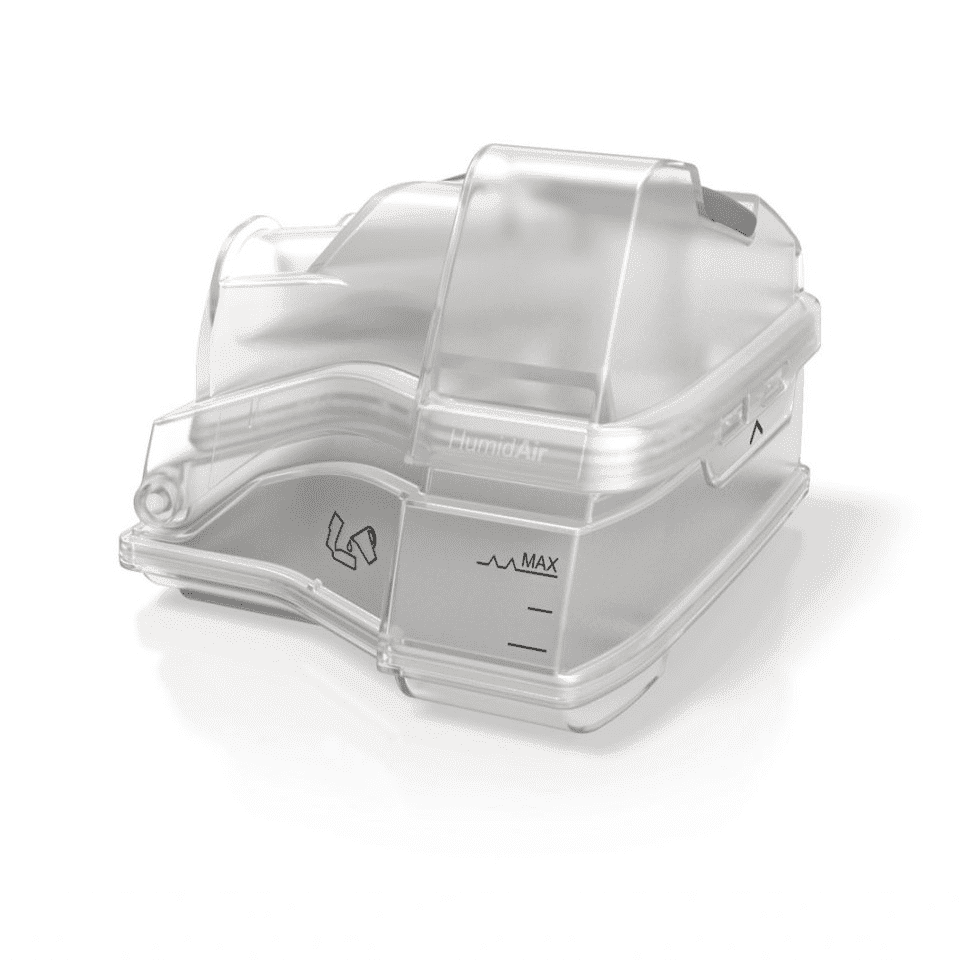
- The humidifier water chamber should be cleaned daily to prevent the buildup of bacteria.
- Allow the water chamber and heating plate to cool fully before removing the chamber and disconnecting any tubing.
- Most chambers should be carefully washed by hand, but some are okay to clean occasionally in the dishwasher. Hand wash the water chamber carefully with warm water and mild soap. The water chamber must be fully rinsed with clean water to prevent any soap residue.
- Allow the water chamber to air dry completely. Before placing the water chamber back on the heating plate, inspect it for any discoloration or cracks. If your water chamber is starting to show signs of wear, or if you have used it for six months, it is time for a replacement. The humidifier should be filled with fresh distilled water each day prior to use.
- The heating element of your CPAP humidifier should also be cleaned regularly to reduce any mineralization or bacteria. Prior to accessing the heating plate, allow your equipment to fully cool. To clean the heating element, wipe it gently with a damp cloth and allow it to fully air dry. Like the water chamber, the heating element should be inspected for signs of damage before reassembling the humidifier. It should be replaced if it is broken or damaged.
- Once it is time to replace your humidifier, you can contact the manufacturer or your care provider directly to place an order.
| Component | Care Guidelines | Replacement Guidelines |
|---|---|---|
| Humidifier Water Chamber | The water chamber should be cleaned carefully on a daily basis. | Replace the water chamber every 6 months. |
| Humidifier Heating Element | Clean regularly to avoid the buildup of minerals and bacteria. Allow the heating element and water to cool down before cleaning. | Replace the heating element when it is broken, damaged, or showing other signs of deterioration. |
How to Clean a CPAP Humidifier
Watch the video below for tips and instructions on how to clean your CPAP humidifier, as well as other parts of your CPAP machine.
How to Choose a CPAP Humidifier
Choosing a CPAP humidifier can be overwhelming when looking at various humidifier styles. We’ll explain the most important factors to consider before buying a humidifier. While understanding these factors can help you make an informed decision, we also recommend checking with your doctor or medical professional to choose a humidifier that is suitable for your treatment.
What to Consider When Purchasing a CPAP Humidifier
There are several factors to consider when purchasing a CPAP humidifier, including compatibility, manufacturer recommendations, humidification style, materials, durability, price, and warranty coverage.
We’ll take a closer look at each of these factors to help you decide on the best CPAP humidifier for your needs. Your personal preferences and needs should also be considered when choosing a device.
Compatibility
Compatibility determines if a humidifier will work with a specific CPAP machine. If you are buying a humidifier separately, compatibility needs to be determined before purchasing.
Standalone humidifiers are typically compatible with a wide range of CPAP machines, but some models are designed for a specific machine. Integrated humidifiers will generally work only with the machines they were designed for.
Manufacturer Recommendations
The manufacturers of CPAP machines and CPAP humidifiers will likely recommend compatible equipment. Following the manufacturer recommendations helps ensure optimal performance, and could extend the humidifier’s lifespan.
The instruction manual will likely also include recommendations for how to clean your equipment and when to replace it.
Humidification Style
CPAP humidifiers have different styles, which indicate how the CPAP air is humidified. Heated humidification sends air through a heated water tank. Heated tubing can help keep the air warm and prevent heavy condensation in the tubing, also known as rainout. Passover humidification is when the air passes over room temperature water and delivers it through a standard or heated tubing.
Materials
CPAP humidifiers are generally made of several components, including a water chamber and a base. Heated humidifiers include a heating element. Humidifiers are generally made of a combination of molded plastic, stainless steel, and silicone, but the materials can vary between models.
Durability
The lifespan of CPAP humidifiers varies by manufacturer. Many humidifiers have an expected service life of two to five years, but the water chamber should be replaced every six months.
Using the humidifier correctly, along with proper care and maintenance, will increase the likelihood of your device working properly for as long as possible.
Price
Prices for CPAP humidifiers vary by retailer, and can be determined by whether the humidifier is standalone, integrated, or built-in.
Built-in humidifiers are part of the CPAP machine, and may increase the overall cost of the CPAP machine itself. Standalone and integrated humidifiers tend to be comparable in price.
Warranty
Warranty coverage from the manufacturer guarantees the integrity of your humidifier and holds the manufacturer responsible for providing a replacement part or repair in the event of a defect.
Humidifiers typically have warranty periods ranging from six months to two years. Warranties generally cover defects in materials or manufacturing, but they do not cover damage resulting from accidents, misuse, water aberration, or unauthorized repairs and alterations.
Built-in CPAP Humidifiers vs. External Humidifiers
When shopping for CPAP humidifiers, you can choose between a built-in or integrated humidifier and a standalone humidifier. Built-in and integrated humidifiers will only work with the specific machine they are designed for. Standalone humidifiers have broader compatibility to work with a variety of CPAP machines.
Integrated humidifiers plug into the CPAP machine they are intended for and will only work with that machine. This provides the advantage of easily being able to remove it for traveling, storage, cleaning, and other purposes.
Standalone humidifiers are components that have their own power cord and a short hose to connect to the CPAP machine. They are usually compatible with several different machines, as long as the machine does not have a built-in or integrated humidifier. However, they tend to take up more space than built-in and integrated humidifiers.
Built-in humidifiers are permanently affixed to the machine and cannot be removed. However, the water chamber can be removed for cleaning. Built-in humidifiers generally take up less space than other types of humidifiers. As a result, they may release less humidity because of their smaller surface area. If a part of the humidifier breaks, the whole unit must be sent in for repair, not just the component that failed.
Frequently Asked Questions About CPAP Humidifiers
We’ll highlight a few additional considerations to keep in mind when using a CPAP humidifier. It is also helpful to discuss any additional concerns or questions with a medical professional or doctor.
What is the best way to clean CPAP humidifiers?
To clean your CPAP humidifier properly, first check any instructions provided by the manufacturer. Wash the water chamber daily using mild soap and warm water. You may also want to disinfect the water chamber weekly. For most models, it is safe to use a vinegar and water solution of 3 parts water, 1 part vinegar.
Cleaning the humidifier regularly will help extend the lifespan of your device and improve its performance. In addition, it prevents the buildup of bacteria in the tubes and chamber.
How much do CPAP humidifiers cost?
Standalone and integrated CPAP humidifiers generally cost between $100 and $300, but pricing will vary depending on the manufacturer and retailer.
Replacement parts are available to purchase for standalone and integrated humidifiers. Many retailers provide the option to buy replacement tubes and water chambers separately.
Built-in humidifiers are included with the CPAP machine. Warranty coverage may come with the machine, or you may purchase for an additional cost.
Are CPAP humidifiers covered by insurance?
Most private insurers cover CPAP humidifiers when determined to be medically necessary. It is best to contact your insurer for further details on their coverage.
Medicare offers coverage for humidifiers when there is a medical need to use them alongside a CPAP device. You will likely be responsible for 20% of the approved cost.
What kind of water should be used in a CPAP humidifier?
Distilled water should always be used in CPAP humidifiers. While filtered tap water is not necessarily harmful, tap water may contain minerals and other deposits that can build up in the water chamber.
Distilled water prevents mineralization in the humidifier, and helps extend its lifespan.
Can you use essential oils in a CPAP humidifier?
Essential oils are not recommended for use in a CPAP humidifier. They are not safe to put in any part of the CPAP machine.
If put in a CPAP machine, oil droplets can be sent deep into your lungs. Even a small amount of these droplets can cause lung irritation. There is also a concern of overexposure to inhalants.
Can you use a CPAP without the humidifier or water chamber?
CPAP machines are usable without a humidifier or water chamber. The machine will continue to disperse dry air to your mask.
If you are in a humid environment, you may find that a humidifier is not necessary. Those who have undergone CPAP therapy for a long time may have adjusted to the treatment and not feel the need for a humidifier. Those who are new to CPAP therapy may find the humidifier helps prevent dryness.
Can I use my CPAP humidifier onboard an aircraft?
Airlines will accept CPAP humidifiers onboard their aircrafts, but each airline will have specific policies regarding the use of equipment onboard. Prior to booking a flight, you may want to call the airline to confirm its specific guidelines for packing and using medical equipment.
Due to their classification as medical devices, CPAP humidifiers can be brought onboard without counting towards the carry-on item limit. Alternatively, you can pack the humidifier with your carry-on luggage. Packing CPAP equipment in your checked luggage is not recommended, as it could be delayed, damaged, or lost in transit.
If you do travel with your humidifier, make sure that it is empty and dry before packing it.
Which humidification style is suitable for me?
Deciding between heated humidification and passover humidification will depend on personal needs and preferences. Heated humidification is suitable for those who are most susceptible to experiencing dryness during therapy and for those in a cooler environment.
Passover humidification is ideal for those who need or prefer a lower pressure setting for their humidifier. Those in warmer climates or who sleep hot may find the cooler air to be more comfortable.


